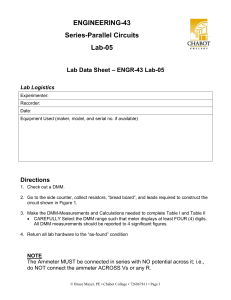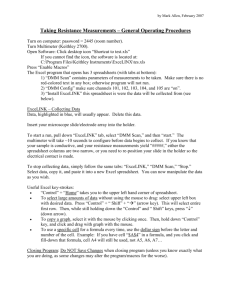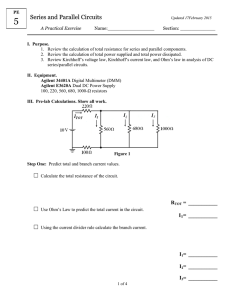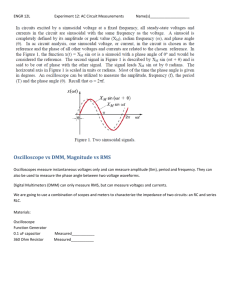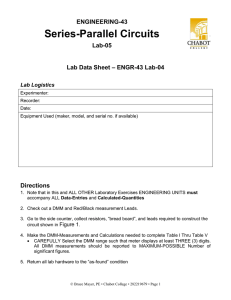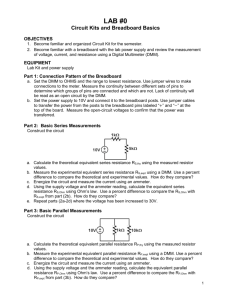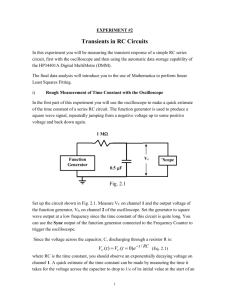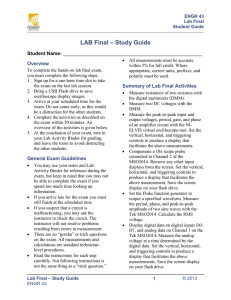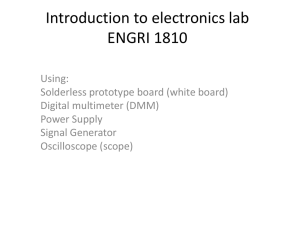MEMORANDUM Date: January 18, 2001 To: Dr.Keith W.Whites From: Ramprasad Potluri
advertisement
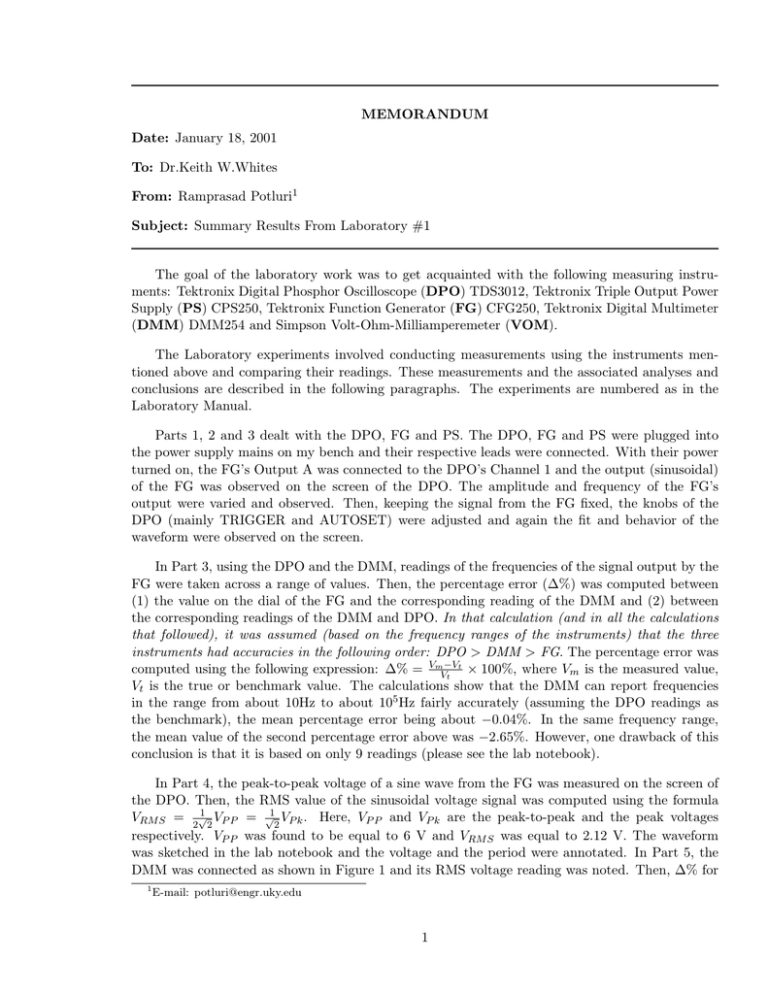
MEMORANDUM Date: January 18, 2001 To: Dr.Keith W.Whites From: Ramprasad Potluri1 Subject: Summary Results From Laboratory #1 The goal of the laboratory work was to get acquainted with the following measuring instruments: Tektronix Digital Phosphor Oscilloscope (DPO) TDS3012, Tektronix Triple Output Power Supply (PS) CPS250, Tektronix Function Generator (FG) CFG250, Tektronix Digital Multimeter (DMM) DMM254 and Simpson Volt-Ohm-Milliamperemeter (VOM). The Laboratory experiments involved conducting measurements using the instruments mentioned above and comparing their readings. These measurements and the associated analyses and conclusions are described in the following paragraphs. The experiments are numbered as in the Laboratory Manual. Parts 1, 2 and 3 dealt with the DPO, FG and PS. The DPO, FG and PS were plugged into the power supply mains on my bench and their respective leads were connected. With their power turned on, the FG’s Output A was connected to the DPO’s Channel 1 and the output (sinusoidal) of the FG was observed on the screen of the DPO. The amplitude and frequency of the FG’s output were varied and observed. Then, keeping the signal from the FG fixed, the knobs of the DPO (mainly TRIGGER and AUTOSET) were adjusted and again the fit and behavior of the waveform were observed on the screen. In Part 3, using the DPO and the DMM, readings of the frequencies of the signal output by the FG were taken across a range of values. Then, the percentage error (∆%) was computed between (1) the value on the dial of the FG and the corresponding reading of the DMM and (2) between the corresponding readings of the DMM and DPO. In that calculation (and in all the calculations that followed), it was assumed (based on the frequency ranges of the instruments) that the three instruments had accuracies in the following order: DPO > DMM > FG. The percentage error was t computed using the following expression: ∆% = VmV−V × 100%, where Vm is the measured value, t Vt is the true or benchmark value. The calculations show that the DMM can report frequencies in the range from about 10Hz to about 105 Hz fairly accurately (assuming the DPO readings as the benchmark), the mean percentage error being about −0.04%. In the same frequency range, the mean value of the second percentage error above was −2.65%. However, one drawback of this conclusion is that it is based on only 9 readings (please see the lab notebook). In Part 4, the peak-to-peak voltage of a sine wave from the FG was measured on the screen of the DPO. Then, the RMS value of the sinusoidal voltage signal was computed using the formula 1 VRM S = 2√ V = √12 VP k . Here, VP P and VP k are the peak-to-peak and the peak voltages 2 PP respectively. VP P was found to be equal to 6 V and VRM S was equal to 2.12 V. The waveform was sketched in the lab notebook and the voltage and the period were annotated. In Part 5, the DMM was connected as shown in Figure 1 and its RMS voltage reading was noted. Then, ∆% for 1 E-mail: potluri@engr.uky.edu 1 FG + DPO A DMM - V- FG COM - - + DPO R1 B + R2 + - C R3 Figure 1: Connection of DPO, FG and DMM Figure 2: Circuit for Part 8 the VRM S calculated in Part 4 was computed with respect to the RMS value given by the DMM (the computed value differed from the observed value by about 3%). Here, the DMM value was assumed as the benchmark, since in computing the RMS value from the readout on the screen of the DPO the screen’s phosphors cannot show us the lines with a precision comparable to that of the DMM’s readings. Even if they could, our eyes cannot see such fine lines. (The sine waveform, which was about 1 − 2 mm thick, occupied 6 cm on the DPO’s screen. Given that each centimeter corresponded to 1 V, the value of Vpp can be calculated as 6 V ±0.1 V. Clearly, this precision cannot beat that of the DMM, which reported the RMS value to 3 places after the decimal point.) In Part 6, the VOM was used to measure the same RMS value measured in Parts 4 and 5. Its reading differed from that of the DMM (benchmark) by about 0.4%. Part 7 onwards the following resistors were used: R1 = 10 kΩ, R2 = 20 kΩ and R3 = 33 kΩ. In Part 7, the resistance of each of the resistors was measured using both the DMM and the VOM. Then, ∆% between the two readings was computed with the DMM reading as the benchmark. The VOM’s readings were approximately 21% less than those of the DMM. In Part 8, the circuit shown in Figure 2 was assembled and a triangular waveform was fed to it from the FG. The peak values of the voltages at the nodes A, B, and C were recorded using the DPO. Also, the instantaneous values of the current at the peak value of the voltage were computed using Ohm’s Law. Voltages were measured at each of the three nodes using the VOM. Since the VOM shows only effective values of the voltages, it is necessary to compute a similar value from the peak value measured using the DPO. So, the above formula for VRM S was used to calculate an approximation to the effective value of the voltage. As can be seen in the lab notebook, the effective values measured by the VOM differ from those that were computed by about 30 − 90%. (The exact expression to compute the RMS voltage of a triangular wave with peak voltage VP k is √ VRM S = VP k / 3.) In Part 9, the “A” terminal of the PS was connected to the rest of the circuit as shown in Figure 3. But first, the source voltage of the PS in open circuit was measured using the VOM. In Part 10, the voltages at nodes A, B and C were measured using the VOM as per the circuit of Figure 3. Then, the measurements were repeated using the DMM in DC-measurement mode. For both sets of measurements the currents were computed. As can be seen from the record in the lab notebook, the currents computed via the DMM’s measurements are uniform in value and equal 114 µA, whereas those computed via the VOM’s measurements give this value only in the average. Part 11 involved setting up the circuit of Figure 4 so that the DMM could measure DC current. The internal resistance of the DMM was ignored. In Part 12, the DC voltage from the PS was increased in small steps from 0 to about 7.5 V. The values of current in the circuit were measured using the DMM. The values of the current were also calculated using Ohm’s law on the source 2 A A R1 Power Supply B + - R2 R1 Power Supply Simpson VOM DMM COM B + - C mA R2 C R3 R3 Figure 3: Circuit for Part 9 Figure 4: Circuit for Part 11 voltage and the sum of the resistances. Finally, the ∆% between these values of the current was calculated. Taking the DMM’s measurements as the benchmark, there is an error of about 3 − 20%. Part 13 was a slight modification of Part 12. Instead of the DMM, now we used the VOM as the amperemeter. The DMM now served as a voltmeter. The procedure of the above experiment was repeated in this setting. The measured values of the current (3, 4, 5 and 7 µA) are nearly 100% less than the corresponding calculated values of the current (0.028, 0.059, 0.075 and 0.111mA). This gives rise to the suspicion that something might have been done wrong in the experiment. However, it is also possible that the VOM is not accurate enough at values of current of the order of a few milliamperes. Part 14 was the last experiment. The circuits built by us were disassembled and the instruments and wires were put back in their original places. 3
